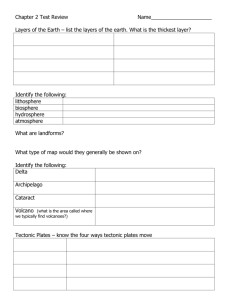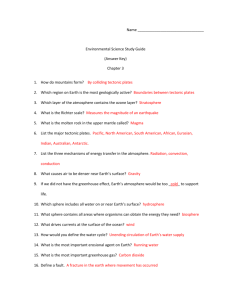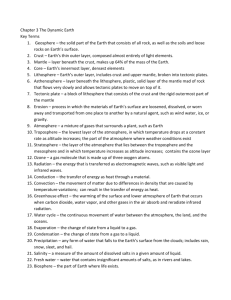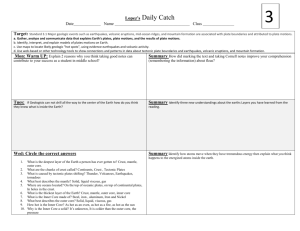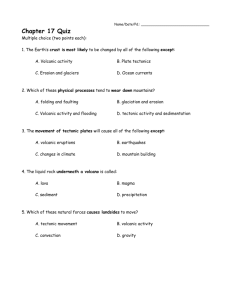Unit 1B Notes KEY
advertisement
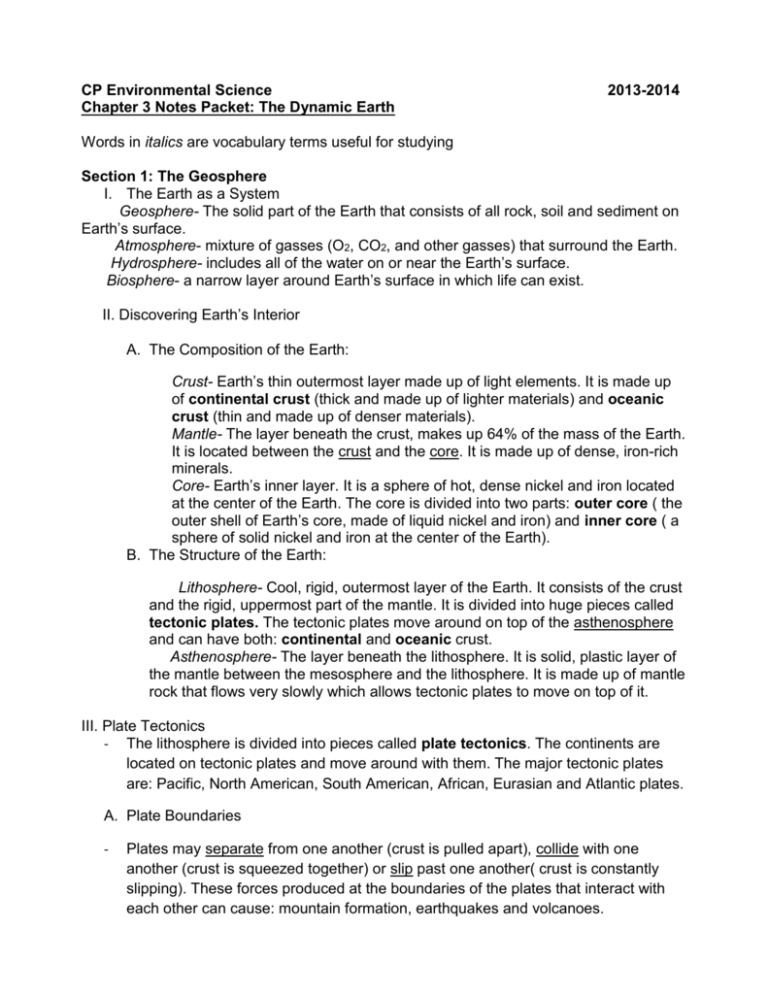
CP Environmental Science Chapter 3 Notes Packet: The Dynamic Earth 2013-2014 Words in italics are vocabulary terms useful for studying Section 1: The Geosphere I. The Earth as a System Geosphere- The solid part of the Earth that consists of all rock, soil and sediment on Earth’s surface. Atmosphere- mixture of gasses (O2, CO2, and other gasses) that surround the Earth. Hydrosphere- includes all of the water on or near the Earth’s surface. Biosphere- a narrow layer around Earth’s surface in which life can exist. II. Discovering Earth’s Interior A. The Composition of the Earth: Crust- Earth’s thin outermost layer made up of light elements. It is made up of continental crust (thick and made up of lighter materials) and oceanic crust (thin and made up of denser materials). Mantle- The layer beneath the crust, makes up 64% of the mass of the Earth. It is located between the crust and the core. It is made up of dense, iron-rich minerals. Core- Earth’s inner layer. It is a sphere of hot, dense nickel and iron located at the center of the Earth. The core is divided into two parts: outer core ( the outer shell of Earth’s core, made of liquid nickel and iron) and inner core ( a sphere of solid nickel and iron at the center of the Earth). B. The Structure of the Earth: Lithosphere- Cool, rigid, outermost layer of the Earth. It consists of the crust and the rigid, uppermost part of the mantle. It is divided into huge pieces called tectonic plates. The tectonic plates move around on top of the asthenosphere and can have both: continental and oceanic crust. Asthenosphere- The layer beneath the lithosphere. It is solid, plastic layer of the mantle between the mesosphere and the lithosphere. It is made up of mantle rock that flows very slowly which allows tectonic plates to move on top of it. III. Plate Tectonics - The lithosphere is divided into pieces called plate tectonics. The continents are located on tectonic plates and move around with them. The major tectonic plates are: Pacific, North American, South American, African, Eurasian and Atlantic plates. A. Plate Boundaries - Plates may separate from one another (crust is pulled apart), collide with one another (crust is squeezed together) or slip past one another( crust is constantly slipping). These forces produced at the boundaries of the plates that interact with each other can cause: mountain formation, earthquakes and volcanoes. B. Plate Tectonics and Mountain Building -where 2 tectonic plates collide, the crust becomes thicker and eventually forms mountain ridges. Ex.: the Himalaya Mountains. IV. Earthquakes - A fault is a break it the Earth’s crust. When rocks that are under stress suddenly break along a fault, a series of ground vibrations is set off. The vibrations of the crust that are caused by slippage along a fault are known as earthquakes. A. Where Do Earthquakes Occur? - The majority of earthquakes takes place at or near tectonic plate boundaries because the rocks between the boundaries are under big stresses due to the plate separation, collision or slipping past each other. B. Earthquake Hazard - Scientists can’t predict when earthquake will take place. But the information of the past earthquake activity and location could help people to prepare for a future earthquakes. V. Volcanoes - A volcano is a mountain built from magma-melted rock-that rises from the Earth’s interior to the surface. At the plate boundaries, the plates can collide or separate from one another. Volcano can occur on land or in the sea, where islands could form. A. Local Effects of Volcanic Eruptions - Volcanic eruptions can be devastating and can cause great human and economic loss. During volcanic eruption, clouds of hot ash, dust and gasses form and can destroy everything in close proximity. Also, the volcanic ash can mix with water and form mudflow. B. Global Effects of Volcanic Eruptions -Volcanic eruption could affect the climate for several years. The ash and gasses could rich the upper atmosphere and block the sunlight that reaches the Earth’s surface. VI. Erosion- The removal and transport of surface material is called erosion. Usually, it is a natural process where the wind and running water move the rocks around and change their appearance. A. Water Erosion - Erosion by both rivers and oceans. Waves from oceans can erode coastlines. Rivers can carve deep gorges (valleys) into the landscape. B. Wind Erosion - Wind can blow away soil very quickly if there is no vegetation on the land. Section 2: The Atmosphere - Earth is surrounded by a mixture of gasses known as the atmosphere. I. Composition of the Atmosphere - 78% Nitrogen (released from erupted volcanoes and decayed plants and animals). 21% Oxygen ( produced by plants) 1% Other gasses (argon, carbon dioxide, methane and water vapor). A. Air Pressure - Earth’s atmosphere is pulled towards Earth’s surface by gravity. The atmosphere is denser near the Earth’s surface, compared to altitudes above 30km (18mi). As a result, the air at high altitudes becomes less dense (less pressure). II. Layers of the Atmosphere -Based on temperature chances at different distances above the Earth’s surface, the atmosphere is divided into 4 layers: A. Troposphere - The layer nearest to the Earth’s surface. All of the weather occurs in this layer. It is the densest layer because it’s closest to Earth’s surface- the most air pressure. Temp. increases as altitude increases. B. Stratosphere - Located above the troposphere. The ozone layer is located in the stratosphere. The ozone absorbs sun’s ultraviolet (UV) energy and worms the air. In this layer, temp. rises as altitude increases. C. Mesosphere - Located above the stratosphere. It is the coldest layer in the atmosphere. D. Thermosphere - Located farthest from the Earth’s surface. In this layer, nitrogen and oxygen are able to absorb solar radiation (X-rays and gamma rays). The least air pressure is present, which results in least collision of particles- low temperature. III. Energy in the Atmosphere -The energy from the sun is transferred in Earth’s atmosphere by 3 mechanisms: - - RadiationThe transfer of energy across space and in the atmosphere. ConductionIs the flow of heat from a wormer object to a colder objects where the objects are placed in direct physical contact. Convection- The transfer of heat by air currents. Hot air rises, cold air sinks. A. Heating of the Atmosphere - Solar energy reaches the Earth in the form of electromagnetic radiation, which includes: visible light, infrared radiation and ultraviolet light. B. Movement of Energy in the Atmosphere - The air that is in constant movement- upward, downward, sideways, causes Earth’s weather. Cool air sinks on the Earth’s surface, worm air rises. This is referred to as convection current. IV. The Greenhouse Effect - The process in which gases trap heat near the Earth is known as greenhouse effect. Without this process, the earth will be too cold for life to exist. Section 3: The Hydrosphere and Biosphere In these 2 layers of the Earth, everything that an organism needs to survive can be found. I. The Hydrosphere and Water Cycle Water Cycle- The continuous movement of water into the air, onto land, and then back to water sources. Evaporation- the process by which liquid water is heated by the sun and then rises into the atmosphere as water vapor. Condensation- the process of water vapor forming water droplets on dust particles. These water droplets form clouds and they combine into bigger drops to form rain. Precipitation- The large droplets of water vapor formed in the clouds, fall from the clouds as rain (also could result in formation of snow, sleet and hail). II. Earth’s Oceans - The oceans are all joined: Atlantic, Pacific, Arctic and the Indian Ocean. They cover more than 70% of the Earth’s surface. A. Ocean Water - The ocean water contains more salt than the fresh water Salinity- of ocean water is the concentration of all the dissolved salts in contains. B. Temperature Zones - The surface of the ocean is warmed by the sun. The depth of the ocean, where sunlight never reaches, is very cold and has a temperature close to freezing. C. A Global Temperature Regulator - Very important function that the ocean has is to absorb and store energy from sunlight. The capacity of the ocean to store this energy is regulating the temperature in Earth’s atmosphere. D. Ocean Currents - Movements of water that occur at or near the surface of the ocean. They are wind driven and result from global wind patterns. III. Fresh Water- 3% of the Earth’s water is fresh water. Most of this water is locked up in icecaps and glaciers. The rest of the fresh water is found in lakes, rivers, wetlands, aquifers and the atmosphere. A. River Systems - A network of streams that drains an area of land. It contains all of the land drained by river, including the main river and all its tributaries (small streams or rivers that flow into larger ones). IV. Groundwater- Rain and melting snow sink into the ground and run off the land. This water is called groundwater. It is used as drinking water as well as water for the agriculture and the industry. A. Aquifers - A rock layer that store and allow the flow of ground water.
